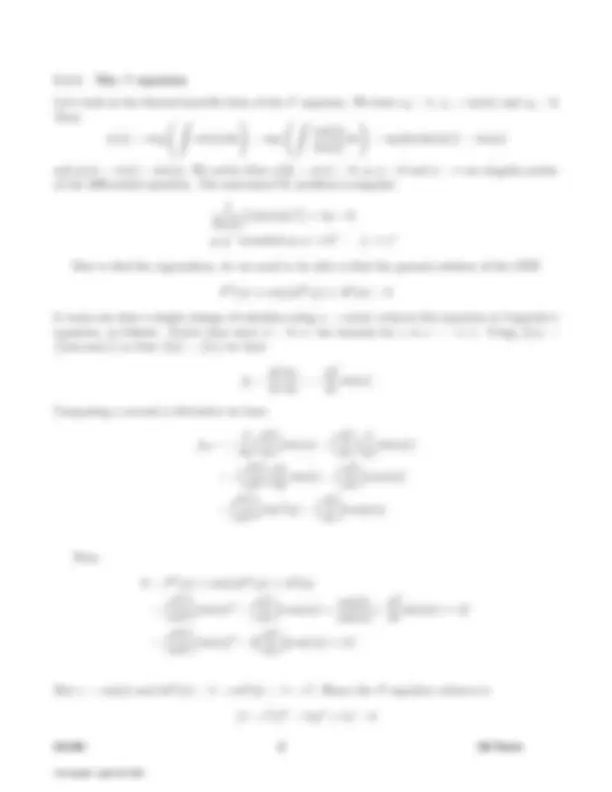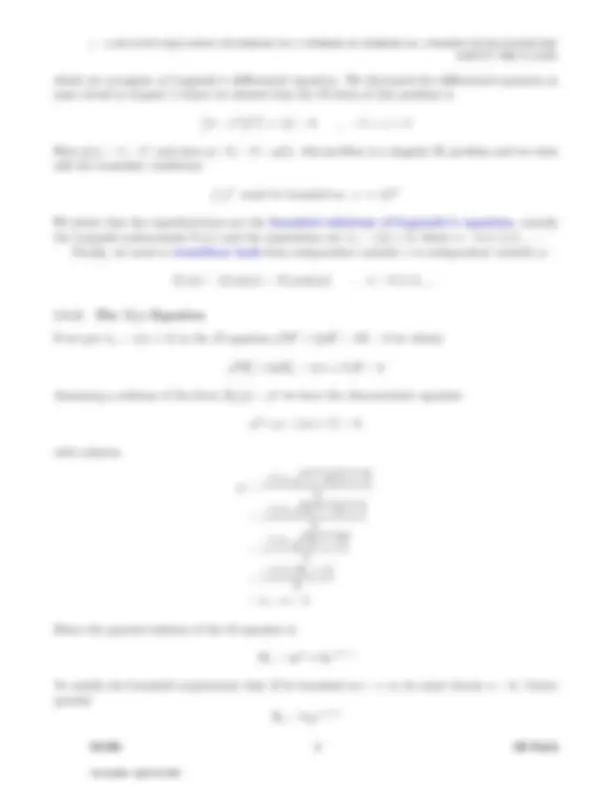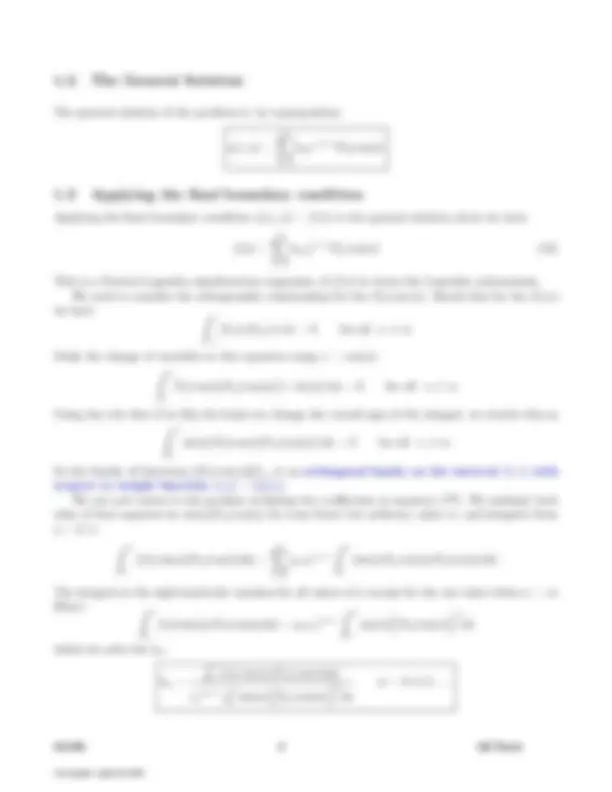





Study with the several resources on Docsity

Earn points by helping other students or get them with a premium plan


Prepare for your exams
Study with the several resources on Docsity

Earn points to download
Earn points by helping other students or get them with a premium plan
Community
Ask the community for help and clear up your study doubts
Discover the best universities in your country according to Docsity users
Free resources
Download our free guides on studying techniques, anxiety management strategies, and thesis advice from Docsity tutors
Our goal is to study Laplace's equation in spherical coordinates in space. ... LAPLACE'S EQUATION EXTERIOR TO A SPHERE IN SPHERICAL COORDS WITH SYMMETRY.
Typology: Exams
1 / 5

This page cannot be seen from the preview
Don't miss anything!




Our goal is to study Laplace’s equation in spherical coordinates in space. Here we will use the Laplacian operator in spherical coordinates, namely
∆u = uρρ +
ρ uρ +
ρ^2
uφφ + cot(φ)uφ + csc^2 (φ)uθθ
Recall that the transformation equations relating Cartesian coordinates (x, y, z) and spherical coordinates (ρ, θ, φ) are:
x = ρ cos(θ) sin(φ) (2) y = ρ sin(θ) sin(φ) (3) z = ρ cos(φ) (4)
REMARK: I need to warn you about the figure #6.11 on page 217. Someone got confused when these were make as the two diagrams in figure 6.11 do not even agree. The problem is that both r and ρ are being used in two distinct ways, and the author is somehow confused. I’m taking the point of that the corrdinate that runs directly from the origin to the point P in space is denoted ρ. The greek symbol ρ will NOT be used as for the radius of a sphere.
MA401 1 LK Norris MA401 1 LK Norris MA401 1 LK Norris
As discussed in the textbook, Laplace’s equation in spherical coordinates for the function u(ρ, θ, φ) takes the form uρρ +
ρ uρ +
ρ^2
uφφ + cot(φ)uφ + csc^2 (φ)uθθ
We again consider the case where u has rotational symmetry about the z-axis so that u depends on only r and θ. We consider the following Boundary Value Problem where the equations hold in the region exterior to a sphere of radius r 0 :
Laplace’s equation exterior to a sphere (Exercise 7, page 229) Solve Laplace’s equation with rotational symmetry (i.e. uθ = 0) for u(r, φ)
uρρ +
ρ
uρ +
ρ^2
uφφ + cot(φ)uφ
= 0 0 < r 0 < ρ , 0 < φ < π (6)
subject to the boundary conditions (7) u(ρ, φ) = f (φ) , 0 < φ < π (8) solutions bounded as r → ∞ (9)
REMARK: This problem is complementary to the problem of Laplace’s equation in a sphere (pages 217-219) and discussed in the pdf
Separating variables as u(ρ, φ) = R(ρ)F (φ) we obtain from substitution in to the PDE the equation
R′′F +
ρ
ρ^2
RF ′′^ + cot(φ)RF ′
Dividing by RF , canceling common factors, multiplying by ρ^2 and rearranging leads to the equation ρ^2 R′′^ + 2ρR′ R
F ′′^ + cot(φ)F ′ F = λ
where we have set both sides equal to the common constant λ. Hence we obtain two equations:
ρ^2 R′′^ + 2ρR′^ − λR = 0 (10) F ′′^ + cot(φ)F ′^ + λF = 0 (11)
It is clear that the R equation is a Cauchy-Euler equation which we will be able to solve once we know λ. So we turn to the F equation, which is one we have not studied this semester. We need an eigenvalue problem in the φ variable.
MA401 2 LK Norris MA401 2 LK Norris MA401 2 LK Norris
which we recognize at Legendre’s differential equation. We discussed the differential equation in some detail in chapter 4 where we showed that the SL-form of this problem is
[(1 − x^2 )f ′)′] + λf = 0 , − 1 < x < 1
Here p(x) = 1 − x^2 , and since p(−1) = 0 = p(1). this problem is a singular SL problem and we must add the boundary conditions
f, f ′^ must be bounded as x → ± 1 ∓
We know that the eigenfunctions are the bounded solutions of Legendre’s equation, namely the Legendre polynomials Pn(x) and the eigenvalues are λn = n(n + 1) where n = 0, 1 , 2 , 3 ,.... Finally, we need to transform back from independent variable x to independent variable φ.
Fn(φ) = f (cos(φ) = Pn(cos(φ)) , n = 0, 1 , 2 ,...
1.1.2 The R(ρ) Equation If we put λn = n(n + 1) in the R equation ρ^2 R′′^ + 2ρR′^ − λR = 0 we obtain
ρ^2 R′′ n + 2ρR′ n − n(n + 1)R = 0
Assuming a solution of the form Rn(ρ) = ρp^ we have the characteristic equation
p^2 + p − n(n + 1) = 0
with solution
p =
1 + 4n(n + 1) 2 =
4 n^2 + 4n + 1 2 =
(2n + 1)^2 2 = − 1 ± (2n + 1) 2 = n, −n − 1
Hence the general solution of the R equation is
Rn = aρn^ + bρ−n−^1
To satisfy the bounded requirement that R be bounded as r → ∞ we must choose a = 0. Conse- quently Rn = bnρ−n−^1
MA401 4 LK Norris MA401 4 LK Norris MA401 4 LK Norris
The general solution of the problem is, by superposition
u(r, φ) =
n=
bnρ−n−^1 Pn(cos(φ)
Applying the final boundary condition u(r 0 , φ) = f (φ) to the general solution above we have
f (φ) =
n=
bnr− 0 n−^1 Pn(cos(φ) (12)
This is a Fourier-Legendre eigenfunction expansion of f (φ) in terms the Legendre polynomials. We need to consider the orthogonality relationships for the Pn(cos(φ)). Recall that for the Pn(x) we have (^) ∫ (^1)
− 1
Pn(x)Pm(x) dx = 0 for all n 6 = m
Make the change of variables in this equation using x = cos(φ): ∫ (^0)
π
Pn(cos(φ)Pm(cos(φ))(− sin(φ) dφ = 0 for all n 6 = m
Using the rule that if we flip the limits we change the overall sign of the integral, we rewrite this as ∫ (^) π
0
sin(φ)Pn(cos(φ)Pm(cos(φ)) dφ = 0 for all n 6 = m
So the family of functions {Pn( cos(φ)}∞ n=0 is an orthogonal family on the interval [0, π] with respect to weight function w(φ) = sin(φ). We can now return to the problem of finding the coefficients in equation (??). We multiply both sides of that equation by sin(φ)Pm( cos(φ) for some fixed, but arbitrary value m, and integrate from φ = 0..π: ∫ (^) π
0
f (φ) sin(φ)Pm(cos(φ)dφ =
n=
anr− 0 n−^1
∫ (^) π
0
sin(φ)Pm(cos(φ)Pn(cos(φ)dφ
The integral on the right-hand-side vanishes for all values of n except for the one value where n = m. Hence (^) ∫ (^) π
0
f (φ) sin(φ)Pm(cos(φ)dφ = amr− 0 m−^1
∫ (^) π
0
sin(φ)
Pm(cos(φ)
dφ
which we solve for bm:
bm =
∫ (^) π 0 f^ (φ) sin(φ)Pm(cos(φ)dφ r− 0 m−^1
∫ (^) π 0 sin(φ)
Pm(cos(φ)
dφ
m = 0, 1 , 2 ,...
MA401 5 LK Norris MA401 5 LK Norris MA401 5 LK Norris